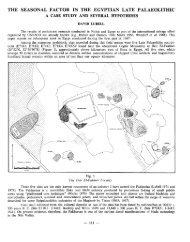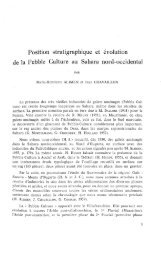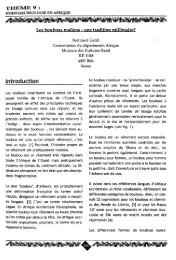Tichitt-Walata and the Middle Niger - PanAfrican Association of ...
Tichitt-Walata and the Middle Niger - PanAfrican Association of ...
Tichitt-Walata and the Middle Niger - PanAfrican Association of ...
Create successful ePaper yourself
Turn your PDF publications into a flip-book with our unique Google optimized e-Paper software.
434 Kevin C. MacDonald<br />
Ndondi Tossokelfacies, Dhar <strong>Tichitt</strong> tradition (Fig. 4)<br />
Elements <strong>of</strong> <strong>the</strong> Ndondi Tossokel tradition first appeared like uninvited guests in elements <strong>of</strong> <strong>the</strong><br />
Kobadi assemblage illustrated by Mauny (1972: Plate n.8-10). In retrospect, parallels between <strong>the</strong>se<br />
vessels <strong>and</strong> those from <strong>Tichitt</strong>-<strong>Walata</strong> should have been obvious at <strong>the</strong> time (Mauny 1972: Plates V<br />
VII; Holl 1986: Fig.23). However it was not until I had a chance to study <strong>the</strong> Dhar <strong>Tichitt</strong> assemblage<br />
curated by Pat Munson at Indiana University in 1993, that I realised <strong>the</strong> Ndondi Tossokel<br />
tradition <strong>and</strong> that <strong>of</strong> <strong>Tichitt</strong>-<strong>Walata</strong> to be one <strong>and</strong> <strong>the</strong> same (compare Figs 4 <strong>and</strong> 5).<br />
The Ndondi Tossokel tradition comprises both open simple-rimmed vessels <strong>and</strong> closed evertedrimmed<br />
vessels, with <strong>the</strong> latter being <strong>the</strong> more numerous. The everted rim vessels have internal rim<br />
diameters <strong>of</strong> between 12 <strong>and</strong> 22 cm. The diameters <strong>of</strong> open simple rimmed vessels range between<br />
14 <strong>and</strong> 38 cm.<br />
In addition to <strong>the</strong> distinctive shape <strong>of</strong> <strong>the</strong>ir everted rims (cf. Fig. 4 for <strong>the</strong> three principal variations),<br />
<strong>the</strong>ir decor <strong>and</strong> its manner <strong>of</strong> application are most characteristic. Tightly spaced cord-wrapped<br />
cord roulettes descending vertically from <strong>the</strong> lip or collar <strong>of</strong> <strong>the</strong> vessel are a hallmark <strong>of</strong> Ndondi<br />
Tossokel wares, comprising between 39 <strong>and</strong> 59% <strong>of</strong> total motif occurrences. Additionally, impressions<br />
using <strong>the</strong> same tool are common. O<strong>the</strong>r decor attributes include applied plastic nubbins <strong>and</strong><br />
fillets (cf. Rye 1981: 94) which are usually in <strong>the</strong> shape <strong>of</strong> teats <strong>and</strong> are applied below or within <strong>the</strong><br />
b<strong>and</strong> <strong>of</strong> cord-wrapped stick decor, <strong>and</strong> simple incised lines or arcs (Fig. 4b). Red slip is also very<br />
common, with traces visible on <strong>the</strong> lip <strong>of</strong> most vessels. The fabric <strong>of</strong> Ndondi Tossokel pottery is<br />
distinctive, usually consisting <strong>of</strong> grog <strong>and</strong> coarse s<strong>and</strong>, sometimes augmented by chaff (ca. 5-30%<br />
<strong>of</strong> sherds depending on <strong>the</strong> assemblage). In texture, <strong>the</strong>y are harder than Beretouma or Kobadi<br />
wares, <strong>and</strong> tend to have thinner walls.<br />
Although lithics are scarce in <strong>the</strong> Merna, probably due to <strong>the</strong> lack <strong>of</strong> local rock sources aside<br />
from schist <strong>and</strong> s<strong>and</strong>stone, Ndondi Tossokel sites usually provide an assortment <strong>of</strong> projectile points<br />
comparable to those known from Dhars <strong>Tichitt</strong> <strong>and</strong> <strong>Walata</strong> (cf. Amblard 1984, types 68, 78 <strong>and</strong> 79).<br />
Also, polished stone hachettes, stone rings <strong>and</strong> beads which correlate well with <strong>the</strong> findings <strong>of</strong><br />
Amblard (1984) are associated with <strong>the</strong> Ndondi Tossokel facies.<br />
In most instances <strong>the</strong> Ndondi Tossokel sites are characterised by <strong>the</strong> presence <strong>of</strong> what may be<br />
called "mini-middens". These are relatively small, one to five metre diameter, rounded mounds no<br />
more than 50 cm in height containing broken pottery, stone chips <strong>and</strong> bone. In between <strong>the</strong>se <strong>the</strong>re<br />
is only a thin scatter <strong>of</strong> cultural materials. Munson (pers. comm.) has suggested that similar "bumps"<br />
observed in <strong>the</strong> Dhar <strong>Tichitt</strong> region, were wind-eroded rubbish pits or sherd-lined earth ovens.<br />
Alternatively, <strong>the</strong>se could be <strong>the</strong> remains <strong>of</strong> refuse accumulations from beside living areas, or even<br />
hydrological phenomena. Still, it is interesting that "mini-middens;' do not occur at sites <strong>of</strong> o<strong>the</strong>r<br />
traditions situated within <strong>the</strong> inundatable plain.<br />
Except when <strong>the</strong>y are mixed with Beretouma ceramics, Ndondi Tossokel facies sites do not<br />
occur within <strong>the</strong> ancient floodplain, but on its margins (Fig. 1). They feature little debris accumulation,<br />
with <strong>the</strong>ir deposits never rising more than a metre above <strong>the</strong> surrounding area. In size <strong>the</strong>y are<br />
much smaller than Kobadi sites, usually not exceeding 1.5 ha. A notable exception to this is <strong>the</strong> 6 ha<br />
escarpment-top occupation <strong>of</strong> Saberi Faita, but it is only superficially stratified. These sites give <strong>the</strong><br />
impression <strong>of</strong> ephemeral occupations by highly mobile groups.<br />
Cattle <strong>and</strong> ovicaprine remains, as well as terracotta cattle statuettes, have been positively associated<br />
with Ndondi Tossokel facies ceramics at Kolima-Sud <strong>and</strong> o<strong>the</strong>r sites (MacDonald 1994).<br />
This brings into question claims <strong>of</strong> Raimbault (et al. 1987) concerning <strong>the</strong> association <strong>of</strong> cattle<br />
remains with <strong>the</strong> Kobadi tradition. As has been argued elsewhere, we believe it more probable that<br />
cattle remains at Kobadi stem from intrusive Ndondi Tossokel facies deposits at <strong>the</strong> site (MacDonald<br />
<strong>and</strong> Van Neer 1994).





